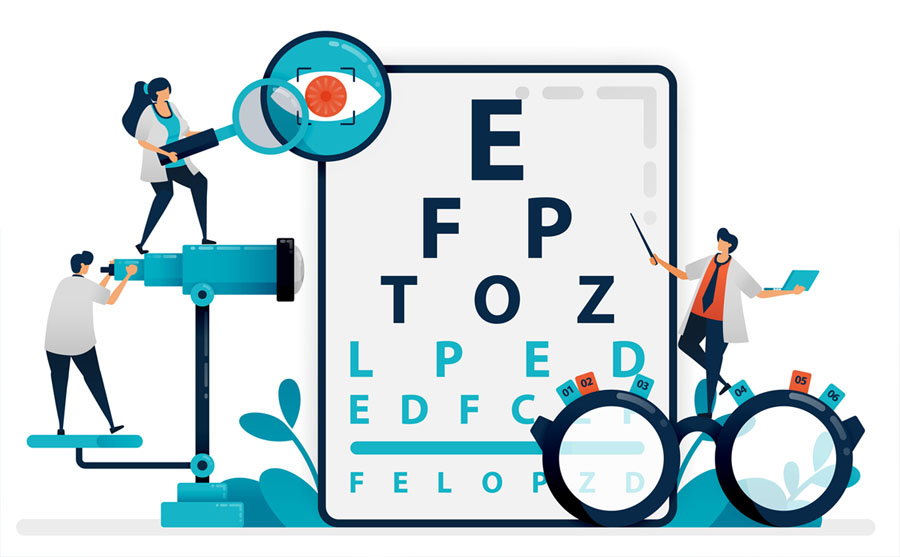Diagnostic Assessment of the Eye
This test determines your eyeglass or contact lens prescription by measuring how light bends in your eye.
It helps diagnose vision issues like nearsightedness, farsightedness, and astigmatism.
You will read letters on a chart while looking through different lens options.
Your doctor will use these results to provide the most accurate vision correction.
A detailed scan that maps the shape and curvature of your cornea.
It is used for diagnosing corneal diseases, fitting contact lenses, and planning surgeries like LASIK.
The test is quick, painless, and involves looking at a pattern of lights. It helps detect conditions like keratoconus and irregular astigmatism.
A non-invasive imaging test that provides high-resolution cross-sectional images of the retina and optic nerve.
It helps diagnose and monitor conditions like glaucoma, macular degeneration, and diabetic retinopathy.
The test is quick and painless, using light waves to create detailed eye scans. Your doctor can use OCT to track changes in your eye health over time.
An ultrasound imaging test used to examine the internal structures of the eye.
It is helpful when the eye’s view is blocked by cataracts, bleeding, or other conditions.
A small probe with gel is placed on the eyelid to create detailed images.
This test helps diagnose retinal detachment, tumors, and other eye diseases.
These tests measure intraocular pressure (IOP) to screen for glaucoma.
The applanation tonometer gently touches the eye after numbing drops are applied.
The air-puff tonometer uses a quick burst of air to measure eye pressure without contact. Both methods are fast, painless, and essential for detecting high eye pressure.
This test measures the thickness of your cornea, which affects intraocular pressure readings.
It is important for assessing glaucoma risk and determining candidacy for LASIK surgery.
A small probe or light-based device is used to take painless, quick measurements.
Knowing your corneal thickness helps ensure accurate eye pressure readings.
Photoscreening is a non-invasive, automated screening technique that uses a specialized camera or device to capture images of a child’s eyes. These images analyze the light reflexes from the retina to detect abnormalities in alignment, refractive errors, and other risk factors for amblyopia. It is particularly useful in preverbal children or those with developmental delays who cannot participate in conventional visual acuity testing.
A detailed examination of the front and back of the eye using a microscope and bright light.
It helps detect cataracts, corneal disorders, infections, and retinal diseases.
You will rest your chin on a support while the doctor examines your eye. This test provides a magnified view of your eye for precise diagnosis.
A test that measures your peripheral (side) vision and detects blind spots.
It is commonly used to diagnose and monitor glaucoma and neurological conditions.
You will press a button when you see flashing lights in different areas.
This test helps detect early signs of vision loss before symptoms appear.
A high-tech imaging system that evaluates skin health and complexion.
It detects fine lines, wrinkles, pigmentation, and UV damage using advanced scanning.
The analysis helps create a personalized skincare plan for better skin health.
It is a painless and quick procedure used in cosmetic and dermatology clinics.
A test that measures how light waves pass through your eye to detect vision imperfections.
It identifies subtle distortions not found in standard eye exams.
Wavefront analysis is often used for customized LASIK and other refractive surgeries. It ensures sharper vision by correcting even minor optical irregularities.
An advanced scan that measures the length and curvature of the eye.
It is essential for selecting the correct artificial lens before cataract surgery.
The test is non-contact , Proper measurements help improve visual outcomes after lens implantation.
A test that assesses your ability to distinguish different colors.
It helps diagnose color blindness and detects certain eye or neurological conditions.
You will be shown patterns or numbers made of colored dots to determine any deficiencies. This test is commonly used for occupational screenings and eye health evaluations.
Retinoscopy is an essential objective technique used by eye care professionals to assess refractive errors, such as myopia, hyperopia, astigmatism, and presbyopia. This diagnostic test helps determine the refractive status of the eye without requiring subjective feedback from the patient, making it particularly valuable for young children, individuals with communication difficulties, or patients with cognitive impairments.
